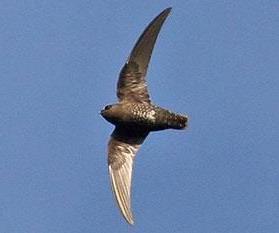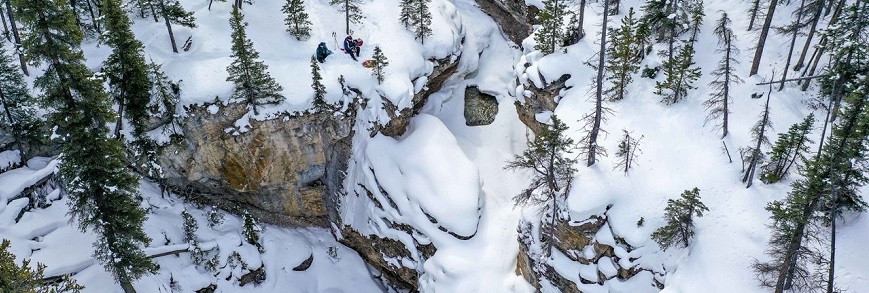
Amar Athwal
Black swift
Jasper National Park
Quick facts
Eats flying insects
Lays only one egg per year
Nests on cliffs near waterfalls
Winters in South America, where they remain in flight - they don’t even land to sleep!
SARA status: Endangered (2019)

Black swifts (Cypseloides niger) are recognized by their black feathers, streamlined bodies and long, curved and pointed wings. Black swifts spend a lot of time at high altitudes and in hard-to-reach places.
Sometimes they fly so high that they cannot be seen with the naked eye. They return to roost at night in nests built on cliff walls, usually in the shade of a deep canyon with a waterfall nearby. Each year, they lay a single egg in a mossy nest in shallow pockets or ledges along cliff walls.
Where they live
Black swifts travel thousands of kilometres each year, flying from summer breeding grounds in North America to wintering grounds in Central or South America.
About 80% of the North American population of black swifts are found in British Columbia, and a very small portion in Alberta. They may be seen alone or in small flocks, flying in and out of canyons or foraging high above for flying insects.
Black swifts are a rare sight in Jasper National Park. Waterfalls and deep canyons such as Athabasca Falls and Maligne Canyon are the best places to look for them. Head to Maligne Canyon and look for a black swift information panel just upstream of Third Bridge.

Why they are at risk
Migratory birds that eat flying insects have significantly declined around the world since the 1970s. The cause of this decline is likely the combined effects of many factors, including declining insect populations, habitat loss, and climate change.
Flying insect declines
The global decline in flying insects is not well understood. Some possible reasons include: 1) the use of pesticides – which are chemicals used to control weeds, insects and fungus, 2) methods used to boost agricultural production that affect soil and water sources, 3) extreme weather events, 4) destruction of wetlands and 5) the warming climate. Less bugs means less food for migratory birds.
Climate change
Climate change may affect the black swift, its habitat and its migration routes in many ways. Changes to the patterns and severity of extreme weather events like fires, droughts and hurricanes all have the potential to impact the black swift and the availability of its insect prey.
Climate change is also shrinking glaciers and decreasing snowpack levels. This is likely to reduce stream flow in many locations, causing nesting sites in canyons and waterfalls to dry out.
Human development and activity
Habitat loss due to intensive agriculture and deforestation is affecting the black swift’s wintering grounds in South America.
How we are helping
Protecting nesting sites
Known nesting sites such as Athabasca Falls, Maligne Canyon, Two Valley Canyon and Pleckaitis Canyon are closed during nesting season. The closures prohibit climbing and rappelling in these canyons from the end of May to the end of September.
Monitoring
We are identifying waterfalls in Jasper National Park that are suitable black swift nesting sites to help us decide where to perform surveys.
We observe birds leaving and returning to their nests at sunrise and sunset. We use thermal cameras during visual surveys to confirm sightings.
We monitor the bird sighting database at ebird.org. Share your sightings to contribute to this citizen science project.

Jasper National Park biologists survey canyons to look for black swift nests. This is one case where drones can be used safely by Parks Canada staff to research and monitor a species at risk.
How you can help
Do not climb or rappel in canyons that are closed to minimize disturbance to black swifts and to protect their habitat. For more information about closures, visit parkscanada.gc.ca/jasper-alerts.
Learn more
- Date modified :